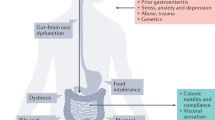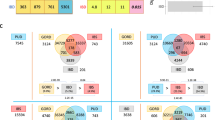Abstract
There is evidence to suggest that genetic factors contribute to the manifestation of functional gastrointestinal disorders (FGID). As such, it is important to note that FGID are heterogeneous; they have quite different clinical features and (probably) different underlying pathophysiologic mechanisms. Evidence from family and twin studies indicates that there is clustering of FGID in families and increased concordance in monozygotic compared with dizygotic twins. The clinical features of FGID implicate polymorphisms in the genes that encode adrenergic, opioidergic or serotonergic receptors, as well as in the G-protein β3 subunit (GNB3) gene and serotonin-transporter genes, in their manifestations. As mediators or regulators of mucosal inflammation can trigger events that ultimately result in manifestations of FGID, polymorphisms in genes that encode proteins with immunomodulatory and/or neuromodulatory features (e.g. OPRM1, IL4, IL4R, TNF) might also have a role in the manifestation of FGID. A two-step model for the role of genetic factors in the manifestation of functional gastrointestinal pain can, therefore, be proposed. In the presence of specific hereditary factors, environmental factors that do not usually cause long-term functional alterations are linked to the manifestation of symptoms.
Key Points
-
The pathogenesis of functional gastrointestinal disorders is probably multifactorial, and includes genetic and environmental factors
-
Polymorphisms of genes that encode cytokines and influence immune function are thought to contribute to the onset of symptoms in at least a subgroup of patients with irritable bowel syndrome
This is a preview of subscription content, access via your institution
Access options
Subscribe to this journal
Receive 12 print issues and online access
$209.00 per year
only $17.42 per issue
Buy this article
- Purchase on Springer Link
- Instant access to full article PDF
Prices may be subject to local taxes which are calculated during checkout



Similar content being viewed by others
References
Drossman DA et al. (2002) AGA technical review on irritable bowel syndrome. Gastroenterology 123: 2108–2131
Talley NJ and Vakil N (2005) Guidelines for the management of dyspepsia. Am J Gastroenterol 100: 2324–2337
Tack J et al. (2006) Functional gastroduodenal disorders. Gastroenterology 130: 1466–1479
Talley NJ et al. (1999) Functional gastroduodenal disorders. Gut 45 (Suppl 2): II37–II42
Longstreth GF et al. (2006) Functional bowel disorders. Gastroenterology 130: 1480–1491
Thompson WG et al. (1999) Functional bowel disorders and functional abdominal pain. Gut 45 (Suppl 2): II43–II47
Hall W et al. (2003) Gastric mucosal mast cells are increased in Helicobacter pylori-negative functional dyspepsia. Clin Gastroenterol Hepatol 1: 363–369
Dunlop SP et al. (2003) Relative importance of enterochromaffin cell hyperplasia, anxiety, and depression in postinfectious IBS. Gastroenterology 125: 1651–1659
Thornley JP et al. (2001) Relationship of Campylobacter toxigenicity in vitro to the development of postinfectious irritable bowel syndrome. J Infect Dis 184: 606–609
Drossman DA et al. (1999) Psychosocial aspects of the functional gastrointestinal disorders. Gut 45 (Suppl 2): II25–II30 (1999)
Drossman DA et al. (1995) Functional bowel disorders. A multicenter comparison of health status and development of illness severity index. Dig Dis Sci 40: 986–995
Holtmann G et al. (1998) Altered vagal and intestinal mechanosensory function in chronic unexplained dyspepsia. Gut 42: 501–506
Mertz H et al. (1995) Altered rectal perception is a biological marker of patients with irritable bowel syndrome. Gastroenterology 109: 40–52
Walters B and Vanner SJ (2005) Detection of bacterial overgrowth in IBS using the lactulose H2 breath test: comparison with 14C-D-xylose and healthy controls. Am J Gastroenterol 100: 1566–1570
Baumgart D et al. (1999) G protein β3 subunit 825T allele and enhanced coronary vasoconstriction on α2-adrenoceptor activation. Circ Res 85: 965–969
Holtmann G et al. (2004) G-protein β3 subunit 825 CC genotype is associated with unexplained (functional) dyspepsia. Gastroenterology 126: 971–979
Longstreth GF and Wolde-Tsadik G (1993) Irritable bowel-type symptoms in HMO examinees. Prevalence, demographics, and clinical correlates. Dig Dis Sci 38: 1581–1589
Zuckerman MJ et al. (1995) Comparison of bowel patterns in Hispanics and non-Hispanic whites. Dig Dis Sci 40: 1763–1769
Drossman DA et al. (1993) US householder survey of functional gastrointestinal disorders. Prevalence, sociodemography, and health impact. Dig Dis Sci 38: 1569–1580
Houghton LA et al. (2002) The menstrual cycle affects rectal sensitivity in patients with irritable bowel syndrome but not healthy volunteers. Gut 50: 471–474
Whorwell PJ et al. (1986) Non-colonic features of irritable bowel syndrome. Gut 27: 37–40
Locke GR III et al. (2000) Familial association in adults with functional gastrointestinal disorders. Mayo Clin Proc 75: 907–912
Levy RL et al. (2000) Intergenerational transmission of gastrointestinal illness behavior. Am J Gastroenterol 95: 451–456
Mayer EA et al. (1998) Brain–gut interactions: implications for newer therapy. Eur J Surg (Suppl 582): 50–55
Whitehead WE et al. (1997) Pain from rectal distension in women with irritable bowel syndrome: relationship to sexual abuse. Dig Dis Sci 42: 796–804
Levy RL et al. (2001) Irritable bowel syndrome in twins: heredity and social learning both contribute to etiology. Gastroenterology 121: 799–804
Morris-Yates A et al. (1998) Evidence of a genetic contribution to functional bowel disorder. Am J Gastroenterol 93: 1311–1317
Mohammed I et al. (2005) Genetic influences in irritable bowel syndrome: a twin study. Am J Gastroenterol 100: 1340–1344
der Ohe MR et al. (1994) Serotonergic mediation of postprandial colonic tonic and phasic responses in humans. Gut 35: 536–541
Yeo A et al. (2004) Association between a functional polymorphism in the serotonin transporter gene and diarrhoea predominant irritable bowel syndrome in women. Gut 53: 1452–1458
Heils A et al. (1996) Allelic variation of human serotonin transporter gene expression. J Neurochem 66: 2621–2624
Camilleri M et al. (2000) Efficacy and safety of alosetron in women with irritable bowel syndrome: a randomised, placebo-controlled trial. Lancet 355: 1035–1040
Camilleri M et al. (2002) Serotonin-transporter polymorphism pharmacogenetics in diarrhea-predominant irritable bowel syndrome. Gastroenterology 123: 425–432
Bharucha AE et al. (1997) Adrenergic modulation of human colonic motor and sensory function. Am J Physiol 273 (Pt 1): G997–G1006
Viramontes BE et al. (2001) Effects of an α2-adrenergic agonist on gastrointestinal transit, colonic motility, and sensation in humans. Am J Physiol Gastrointest Liver Physiol 281: G1468–G1476
Kobilka BK et al. (1987) Cloning, sequencing, and expression of the gene coding for the human platelet alpha 2-adrenergic receptor. Science 238: 650–656
Lomasney JW et al. (1990) Expansion of the alpha 2-adrenergic receptor family: cloning and characterization of a human alpha 2-adrenergic receptor subtype, the gene for which is located on chromosome 2. Proc Natl Acad Sci USA 87: 5094–5098
Regan JW et al. (1988) Cloning and expression of a human kidney cDNA for an alpha 2-adrenergic receptor subtype. Proc Natl Acad Sci USA 85: 6301–6305
Shannon JR et al. (2000) Orthostatic intolerance and tachycardia associated with norepinephrine-transporter deficiency. N Engl J Med 342: 541–549
Hirafuji M et al. (2001) Noradrenaline stimulates 5-hydroxytryptamine release from mouse ileal tissues via α2-adrenoceptors. Eur J Pharmacol 432: 149–152
Pettersson G et al. (1978) The release of serotonin from rat duodenal enterochromaffin cells by adrenoceptor agonists studied in vitro. Acta Physiol Scand 103: 219–224
Kim HJ et al. (2004) Association of distinct α2 adrenoceptor and serotonin transporter polymorphisms with constipation and somatic symptoms in functional gastrointestinal disorders. Gut 53: 829–837
Gibbs J et al. (1997) Cholecystokinin decreases food intake in rats. 1973. Obes Res 5: 284–290
van der Veek PP et al. (2006) Proximal and distal gut hormone secretion in irritable bowel syndrome. Scand J Gastroenterol 41: 170–177
Wank SA (1995) Cholecystokinin receptors. Am J Physiol 269 (Pt 1): G628–G646
Fourmy D et al. (2002) Structure of cholecystokinin receptor binding sites and mechanism of activation/inactivation by agonists/antagonists. Pharmacol Toxicol 91: 313–320
Cremonini F et al. (2005) Effect of CCK-1 antagonist, dexloxiglumide, in female patients with irritable bowel syndrome: a pharmacodynamic and pharmacogenomic study. Am J Gastroenterol 100: 652–663
D'Amato M and Rovati LC (1997) Cholecystokinin-A receptor antagonists: therapies for gastrointestinal disorders. Expert Opin Investig Drugs 6: 819–836
Varga G et al. (2004) Involvement of endogenous CCK and CCK1 receptors in colonic motor function. Br J Pharmacol 141: 1275–1284
Liebregts T et al. (2005) Effect of E. coli Nissle 1917 on post-inflammatory visceral sensory function in a rat model. Neurogastroenterol Motil 17: 410–414
Adam B et al. (2006) Severity of mucosal inflammation as a predictor for alterations of visceral sensory function in a rat model. Pain 123: 179–186
Spiller RC (2003) Estimating the importance of infection in IBS. Am J Gastroenterol 98: 238–241
Simren M et al. (2002) Quality of life in inflammatory bowel disease in remission: the impact of IBS-like symptoms and associated psychological factors. Am J Gastroenterol 97: 389–396
Neal KR et al. (1997) Prevalence of gastrointestinal symptoms six months after bacterial gastroenteritis and risk factors for development of the irritable bowel syndrome: postal survey of patients. BMJ 314: 779–782
Spiller RC et al. (2000) Increased rectal mucosal enteroendocrine cells, T lymphocytes, and increased gut permeability following acute Campylobacter enteritis and in post-dysenteric irritable bowel syndrome. Gut 47: 804–811
Turner DM et al. (1997) An investigation of polymorphism in the interleukin-10 gene promoter. Eur J Immunogenet 24: 1–8
Gonsalkorale WM et al. (2003) Interleukin 10 genotypes in irritable bowel syndrome: evidence for an inflammatory component? Gut 52: 91–93
van der Veek PP et al. (2005) Role of tumor necrosis factor-alpha and interleukin-10 gene polymorphisms in irritable bowel syndrome. Am J Gastroenterol 100: 2510–2516
Moraes MO et al. (2003) Interleukin-10 promoter haplotypes are differently distributed in the Brazilian versus the Dutch population. Immunogenetics 54: 896–899
Lazarus R et al. (2002) Single-nucleotide polymorphisms in the interleukin-10 gene: differences in frequencies, linkage disequilibrium patterns, and haplotypes in three United States ethnic groups. Genomics 80: 223–228
Meenagh A et al. (2002) Frequency of cytokine polymorphisms in populations from Western Europe, Africa, Asia, the Middle East and South America. Hum Immunol 63: 1055–1061
Mearin F et al. (2004) Splitting irritable bowel syndrome: from original Rome to Rome II criteria. Am J Gastroenterol 99: 122–130
Cardon LR and Bell JI (2001) Association study designs for complex diseases. Nat Rev Genet 2: 91–99
Tabor HK et al. (2002) Candidate-gene approaches for studying complex genetic traits: practical considerations. Nat Rev Genet 3: 391–397
Author information
Authors and Affiliations
Corresponding author
Ethics declarations
Competing interests
The authors declare no competing financial interests.
Rights and permissions
About this article
Cite this article
Adam, B., Liebregts, T. & Holtmann, G. Mechanisms of Disease: genetics of functional gastrointestinal disorders—searching the genes that matter. Nat Rev Gastroenterol Hepatol 4, 102–110 (2007). https://doi.org/10.1038/ncpgasthep0717
Received:
Accepted:
Issue Date:
DOI: https://doi.org/10.1038/ncpgasthep0717
This article is cited by
-
Genetic variants of immune-related genes IL17F and IL10 are associated with functional dyspepsia: A case–control study
Indian Journal of Gastroenterology (2017)
-
Possible etiology of improvements in both quality of life and overlapping gastroesophageal reflux disease by proton pump inhibitor treatment in a prospective randomized controlled trial
BMC Gastroenterology (2013)
-
Host immune response determines visceral hyperalgesia in a rat model of post-inflammatory irritable bowel syndrome
Journal of Gastroenterology (2013)
-
Proinflammatory Cytokine Gene Polymorphisms in Irritable Bowel Syndrome
Journal of Clinical Immunology (2010)
-
T-Helper 1, T-Helper 2, and T-Regulatory Cytokines Gene Polymorphisms in Irritable Bowel Syndrome
Inflammation (2010)



